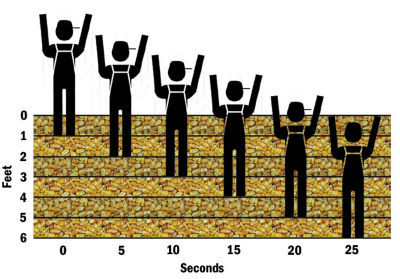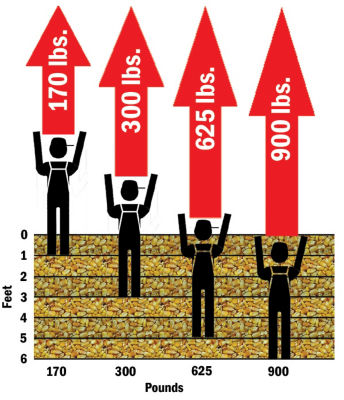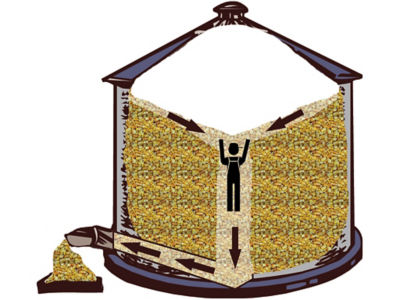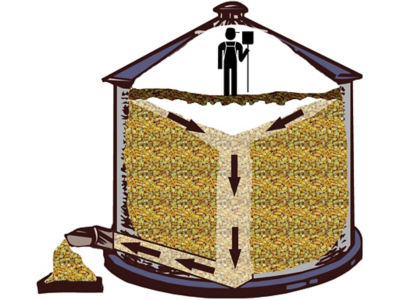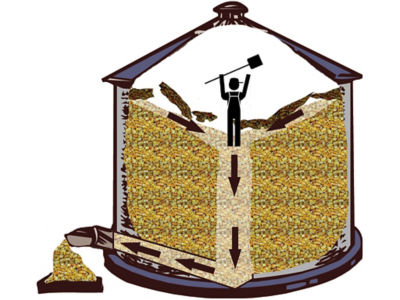5 MIN READ
Safety Around Grain Bins
January 25, 2021
- Grain handling facilities are hazardous and off limits to anyone not authorized.
- Never work alone around grain bins.
- Never enter grain bins when unloading equipment is operating.
- Never enter grain bins without proper safety equipment.
- Train family and employees about grain facility hazards and have emergency procedures in place.
Agricultural activities can be dangerous because of the size and complexity of equipment used for tillage, planting, spraying, harvesting, feeding livestock, grain storage, and many more activities. Beyond the equipment itself, proper safety equipment and clothing may be needed for agricultural activities such as pesticide applications, cleaning grain bins, and working in dusty conditions.
The handling and storing of grain would seem to be a safe activity but it is far from it when an obituary describes the death of a family member or employee due to a grain related accident. The accident can be as innocuous as placing a small child on grain in a wagon. Within moments the child can start sinking into the grain and without supervision can succumb to suffocation.
At the end of 2019, the Purdue Agricultural Confined Space Incident Database (PACSID) had documented 1496 grain storage and handling facility incidents between 1962 and 2019.1 Grain entrapment or engulfment accounted for 1263 of these incidents.1 Additionally, out of 2117 confined space incidents between 1962 and 2019, 1276 cases were fatal (60%).1
Equipment
The power source to any equipment should be turned off before any repairs are made. Locking the power system out is ideal to keep an unknowing person restarting the equipment during the repair.
Power take off (PTO) shafts should be properly covered to prevent entanglement.
Augers should be adequately covered to prevent contact with the auger screw when operating.
Power lines should be underground to prevent inadvertent contact when augers, ladders, or other equipment are raised into operating position.
Grain bins should never be entered with unloading equipment operating, without proper safety equipment, and without a knowledgeable person in grain bin safety watching. Switches that turn unloading equipment on should have a locking mechanism to guard against the system being turned on when a person is in the bin. Safety equipment should include a dust mask or respirator and a safety harness that is attached to a solid point with a rope that has limited range.
Flowing Grain Entrapment
Entering a grain bin, truck, or wagon when unloading augers or equipment is working creates a downward moving mass of grain that can quickly pull individuals into the mass. Entrapment to their knees and waist can occur within 3 to 5 seconds and can be completely covered within 20 to 30 seconds, causing suffocation (Figure 2). The deeper a person sinks into the grain, the required force to pull the person from the grain increases dramatically (Figure 3). The flowing mass can also pull the individual into the unloading auger (Figure 4).
Bridging entrapment can occur when a person walking on crusted grain breaks through and falls into the void below the crust (Figures 5 and 6). Surrounding grain can quickly flow into the void and cover the person, particularly if the unloading auger is operating (Figure 7). Stored grain should be monitored regularly for quality determination to help prevent deterioration and the development of crusted grain. For more information on best practices for managing stored grain, please read article, Post-Harvest Grain Storage Management.
Sources:
1Cheng, Y.H., Nour, M., Field, B., Ambrose, K., and Sheldon, E. 2020. 2019 Summary of U.S. Agricultural Confined Space-Related Injuries and Fatalities. Purdue University. https://extension.entm.purdue.edu/grainsafety/grainEntrapment.php
National Ag Safety Database (NASD). AgHealth Central States Center for Agricultural Safety and Health. University of Nebraska Medical Center. University of Nebraska-Omaha. http://www.unmc.edu/publichealth/cscash/. Additional site: https://www.nasdonline.org/browse/200/grain-handling-harvesting-storage.html.
Krekelberg, E. 2020. Grain bin safety. University of Minnesota Extension. https://extension.umn.edu.
Keimig, J. 2020. Grain bin safety improvements. South Dakota State University Extension. South Dakota State University. https://extension.sdstate.edu/grain-bin-safety-improvements.
Grain bin Safety. Working in and around grain storage and silo enclosures. Agriculture and University Extension. North Dakota State University. https://www.ag.ndsu.edu/farmsafety/Grain-bin-safety/grain-bin-safety.
NCGA urges farmers to practice proper grain bin safety this harvest. 2019. National Corn Growers Association. https://ncga.com/stay-informed/media/in-the-news/article/2019/10/ncga-urges-farmers-to-practice-proper-grain-bin-safety-this-harvest.
8009_S3

